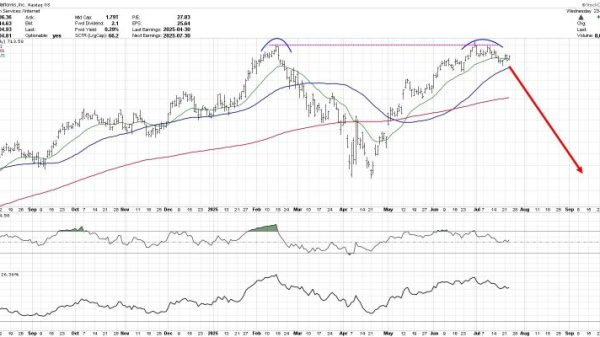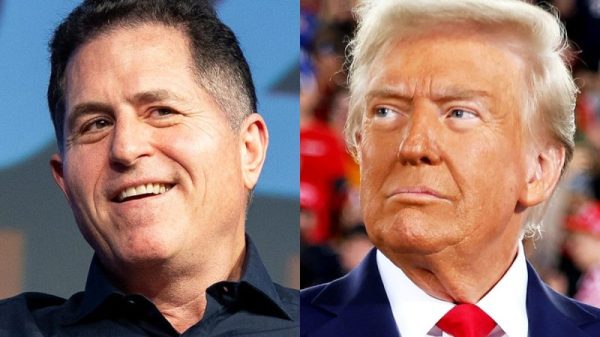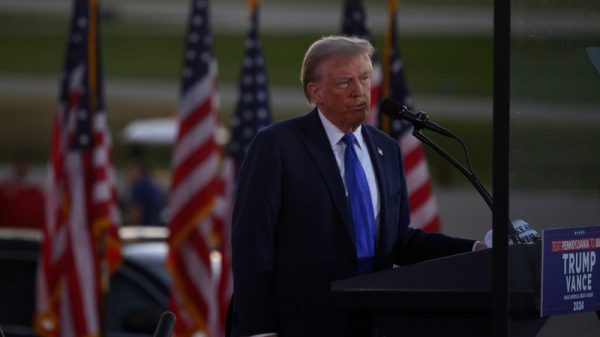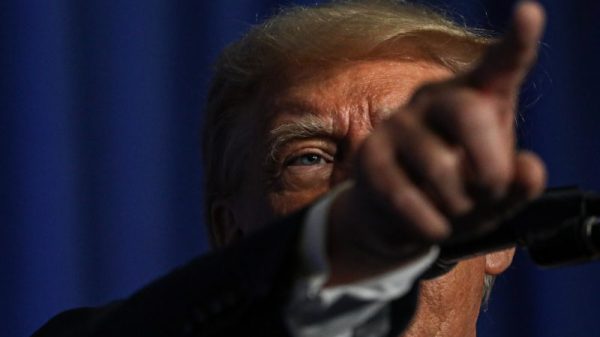As the 2020 election approached, President Donald Trump had two problematic groups of supporters that he didn’t want to alienate. One was the Proud Boys, an extremist group that had already earned a reputation for engaging in violence against opponents. The other was more loosely knit: adherents of the QAnon movement.
QAnon was problematic for very different reasons. While there had been crimes linked to the movement (including at least one killing), the political challenge was primarily that the most fervent supporters held views that were somewhere between bizarre and deranged. There’s an international cabal of prominent people in entertainment and the Democratic Party that worships Satan and traffics children to ingest a chemical they produce? Got it.
Those views sat at the extreme, certainly. But even more anodyne manifestations of QAnonism were dubious, centered on an anonymous figure, Q, who allegedly worked in the Trump administration and was helping the president combat the evil deeds of his enemies. Q began posting cryptic messages online a few months into Trump’s presidency, with tens of thousands of people subsequently parsing them for hidden meaning.
By mid-2018, QAnon was a prominent part of Trump rallies. Supporters held up signs or large “Q’s” to get on camera, with success. By early 2019, after a spate of news stories drawing attention to the movement’s bizarre beliefs, adherents reported being asked to hide any Q insignia at the president’s rallies.
Then the election rolled around. Trump’s campaign slowly began to embrace members of the movement, recognizing its scale and loyalty to his politics. He refused to condemn even the more extreme forms the movement took and, only weeks before Election Day, even endorsed the idea that QAnon members were combating child trafficking.
Trump lost his reelection bid but worked fervently to avoid leaving the White House. That culminated in the riot at the U.S. Capitol on Jan. 6, 2021, an event at which QAnon had a prominent presence.
Then the movement mostly evaporated. Adherents still existed; Trump began elevating their content on his social media platform with regularity. But QAnon simply wasn’t the same force that it had been when he was president.
To explore the reason QAnon lost so much energy — and to figure out where it went — I spoke with The Washington Post’s Will Sommer, author of the book “Trust the Plan: The Rise of QAnon and the Conspiracy That Unhinged America.”
Sommer points to 2020 as the height of the QAnon movement’s size and influence. It wasn’t just Trump’s reelection bid, though that was important, given his role in the purported fight against the elites. It was also the coronavirus pandemic and the Black Lives Matter protests — and even the death of Jeffrey Epstein, a galvanizing point of skepticism about official narratives.
Then came the election and Trump’s response to it — a response that was centered on a wide-ranging, unproven (and untrue) theory about a conspiracy fomented by Democratic elites to keep him out of power. QAnon adherents — who’d come to believe that there would soon be a “storm” in which their evildoing opponents were uprooted, jailed or killed — were paying attention.
“QAnon played a huge role in Jan. 6,” Sommer said. He noted that Ashli Babbitt, the woman killed by a law enforcement officer as she climbed through a window at the Capitol, embraced the movement. So did scores of others arrested for their involvement in the riot. If the Oath Keepers and Proud Boys aimed to be the spark for the unrest that began that day, Sommer explained, QAnon adherents served effectively as the gasoline.
The effort to block Joe Biden’s presidency failed. Trump moved to Florida. Q — generally believed to be a man named Ron Watkins — stopped posting new messages.
“You end up with a sort of reformulated QAnon that is sort of ‘QAnon in the wilderness,’ ” Sommer explained. “It’s no longer ‘this is at hand, the storm,’ but it becomes, you know, perhaps that Trump is secretly still in power or the Biden presidency is being filmed at Tyler Perry Studios or that the election was stolen.”
It was certainly harder to think that Trump was still fighting the satanic cabal from the cozy confines of Mar-a-Lago. But that wasn’t the only reason that QAnon lost steam. Its energy was also co-opted.
“QAnon and these conspiratorial beliefs and a lot of the ideas that were at the core of it … that has become more mainstreamed in the Republican Party,” Sommer explained. “It’s not that the Republican Party rejected QAnon, but that QAnon sort of assimilated into the GOP.”
It was long the case that Trump embraced conspiratorial thinking, even before the advent of QAnon (or even his presidency). This created an unusual dynamic. As one researcher of conspiracy theories explained when I spoke to him in 2017, “the permission that having a conspiracy-theorist-in-chief offers suggests that [conspiracy theorizing] can be much more explicit than it previously was.” Trump’s rhetoric about how he is the target of conspiratorial actors served helped serve as groundwork for QAnon and QAnon-like thinking, and that thinking remained robust even after the QAnon framework fell away.
Sommer notes that this was in part intentional. “QAnon” as a term became toxic in the public eye, giving adherents a reason to abandon the term.
There’s a good example of the evolution that followed Biden’s ascent to the presidency: Rep. Marjorie Taylor Greene (R-Ga.).
“This is someone who was posting on Facebook constantly about QAnon,” Sommer explained. “Her posts about QAnon were really intricate. She was debating the veracity of, what’s a legitimate Q clue? That’s the kind of thing where you don’t just inadvertently tweet ‘where we go one, we go all,’ ” — a QAnon slogan that became a shorthand for signaling at least some alliance with the movement.
Greene won her 2020 bid for the House and stepped away from that past affiliation. But she still embraces extremist claims. And part of her focus during the Republican effort to investigate Joe Biden and his family was that his son was somehow involved in sex trafficking.
For many adherents, the conspiracy simply metastasized.
“If you believe the election was stolen, there’s a whole host of other things you can believe in and QAnon has really provided a buffet of options,” Sommer said. “That’s when it becomes this slide into, ‘Everything is a psy-op.’ ‘The Baltimore bridge collapsing is a psy-op.’ This reflexive suspicion.”
The question then becomes what happens should Trump win reelection to the White House.
Sommer notes that the movement first emerged when Trump’s administration was struggling in late 2017. QAnon presented an alternative picture.
“I think the reason Q took off was that it offered a different world where Trump was constantly winning and fulfilling his promises,” he explained. “Also, it gives you that taste of a political campaign, like, ‘oh, we’re still waging war on those Democrats,’ rather than ‘we’re debating tax cuts.’ ”
As one adherent I spoke to in 2018 put it, “I view it as hope. … Despite all the chaos the country is going through, there is a backbone of what’s taking place behind the scenes.”
Should Trump return to the White House, then, he might bring Q with him — figuratively, at least. The galaxy of voices who promoted QAnon the first time around still exists — voices like “X22 Report,” which has recently hosted figures close to Trumpworld. There’s an army of people who believe that Trump is engaged in a ferocious, clandestine battle against an oppressive, powerful cabal of elites and who will readily elevate that idea given the opportunity or inclination to do so.
Trump would no doubt once again be happy to have their support.





























